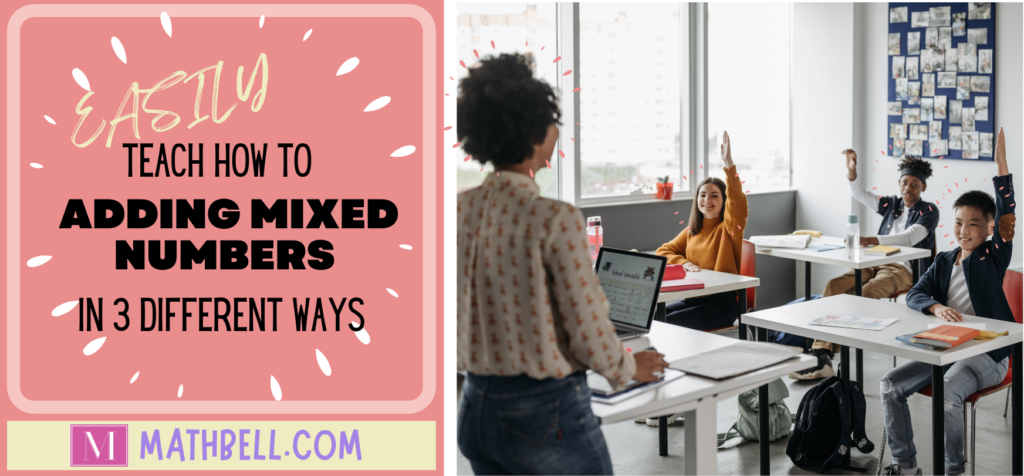Has your elementary student or class of students finally become successful with adding fractions but just the thought of adding mixed numbers frightens them a little or maybe you get frightened a little? You might wonder…”do I really have to teach them and talk about how to adding mixed numbers?”
Well…it’s not as bad as you think.
Watch the video by clicking here

Get your own visual pdf guide to adding mixed numbers similar to this article and the video by clicking here.
How to Adding Mixed Numbers with Like Denominators?
In this article, I am going to share with you three ways in which you can teach your students the process of adding mixed numbers. Since this is a new concept for them, we’ll focus on the how to adding mixed numbers with like denominators.
This will be done by using the CRA Model on the given word problem below.
Using an example, we’re going to look at a problem in context. Here we have a word problem:
Karla wanted to make cupcakes and brownies for her dinner party tomorrow. The cupcakes would need 2 3/10 cups of sugar and the brownies would need 3 5/10 cups of sugar. How much sugar will Karla need to make the cupcakes and brownies for her dinner party?
This skill aligns with the common core state standards:
Common Core Standards for Math

Generally, with the given problem we will be adding 2 3/10 + 3 5/10.
Misconceptions
Before we start, let’s first look at a common misconception that students might have when they are practicing how to adding mixed numbers.
One misconception students may have is that after adding the numerators together, they believe that they will need to add the denominators as well.

Some Things to Consider
This will show you that your students don’t have a full understanding of what a fraction is. In the book, The Common Core Mathematics Companion: The Standards Decoded, by Gojak and Miles, they emphasize the meaning of the numerator and the denominator when referring to misconceptions with adding fractions.
“….the numerator tells the count, or how many, and the denominator describes the piece.” Many students, and some adults, don’t fully understand that the denominator, in these cases, is a descriptive word that describes the size of the pieces, not the number of pieces.
To clarify, when adding mixed numbers, or the fraction pars of the mixed numbers, we need to add the amounts, not the descriptions.

Clarify with an Example
They give a great example in the book. “Since the pieces are the same size, the numerator, or count, is added and the description of the pieces does not change. When I add 2 pieces that are thirds to 3 pieces that are thirds, I will get 5 pieces that are thirds.”
Thinking about it this way can cause you to focus on the denominator as a description and not just a number or digit.
Once students really grasp this then teaching them how to adding mixed numbers becomes much easier.

I highly suggest thinking about possible student misconceptions before teaching a specific lesson to students so you can plan for what they may possibly do.
Some of the links below may be affiliate links. At no extra cost to you, I may earn a small commission based on purchases made through the links.
Using the CRA Model
Teach How to Adding Mixed Numbers Using a Concrete Model
Let’s keep learning by looking at a concrete model of our problem.

For this example, I am going to use cuisenaire rods to represent both mixed numbers. The orange rods will represent the wholes and the white rods will represent the tenth-sized pieces.
Firstly, let’s show our first mixed number, 2 wholes and 3 tenth-sized pieces, or 3 tenths. The white rods are tenth-sized pieces in this scenario because it takes ten of them to be equal to the one whole represented by the orange rods. Next we’re going to join that together with, or add on, our second mixed number, 3 wholes and 5 tenth-sized pieces, or 5 tenths.

Starting with the whole numbers when it comes to adding mixed numbers, you can first join all of the whole numbers together. 2 plus 3 equals 5. There are 5 wholes in all.

Next, combine the 3 tenths with the 5 tenths. 3 tenth-sized pieces plus 5 tenth-sized pieces equals 8 tenth-sized pieces or 8 tenths.

Last, let’s join the 5 wholes together with the 8 tenths. 5 wholes plus 8 tenths equals 5 and 8 tenths.
So returning to the word problem, Karla will need 5 and 8 tenths cups of sugar.

Teach How to Adding Mixed Numbers Using a Picture Representation
Once students are ready, move them along to drawing their own picture models to represent the actions that took place with the concrete model.

This can be done on paper, or a small whiteboard. Here I am drawing it out digitally for those who have students working remotely. I’m using the drawing tools in PowerPoint but you can use any online program that has a whiteboard or a blank white space.

To begin, let’s represent the 2 wholes and and a third whole that is partitioned into tenths. There is no specific model that has to be done.
I find that it is typically easier to draw square or rectangle models than circular models. Whichever type of area models the students are exposed to more is the type of model that they are more likely to draw themselves.
Remember to emphasize that each whole must be the same size.

After drawing the 2 wholes and shading them in, shade in three tenths to represent the fraction part of the mixed number.
Then do the same with the second mixed number. Draw 3 wholes and shade them in. Draw a fourth whole to partition into 10 equal parts.
The models drawn for the second mixed number should be the same as the first mixed number. Shade in five tenths to represent the fraction part of the mixed number.

Next, circle the picture of the wholes in both mixed numbers. When joined together, 2 wholes and 3 wholes equals 5 wholes. Write a 5 after an equal sign somewhere under your picture model.

Now we can add the fractions together. This would be a great time to remind students, or better, ask them, if you are able to add the two fractions together. Are the parts of the wholes the same size?
Consequently, due to drawing the pictures by hand, some students may stare at the pieces and analyze if they were drawn exactly equal to each other. If this happens, refer to the fraction numerals, or the denominators. Do both fractions have tenth-sized pieces? Yes.

As a result of adding 3 pieces that are tenths to 5 pieces that are tenths, we now have 8 pieces that are tenths. We can also say 8 tenths.
Lastly, don’t forget about that whole number! When we add 5 wholes to 8 tenths, we finally get the sum, 5 wholes and 8 tenths, or 5 and 8 tenths.

Abstract: Teach How to Adding Mixed Numbers by Making Connections to an Equation
Following the demonstration of those models, let’s now connect what solving this problem looks like visually to an equation.

Firstly, we can see from the end of the picture model that we circled the 2 wholes and the 3 wholes. With the equation, we can rewrite it with the two whole numbers next to each other and the two fractions next to each other.

Two plus three plus three tenths plus five tenths.
Then add the wholes together to get a sum of 5.

With the fractions, explicitly show to students how the model of 3 tenths and 5 tenths is written in the equation. Also explain that we know the parts are the same size because the denominator for both fractions is tenths (written as 10).

Again we can restate here that when we add 3 pieces that are tenths to 5 pieces that are tenths, we now have 8 pieces that are tenths, or 8 tenths.

Last, combine the 5 wholes with the 8 tenths and the sum is 5 and 8 tenths.

To sum up, teaching your students how to add mixed numbers can seem difficult but it shouldn’t be.
Spend more time on firming up their understanding of fractions and what mixed numbers are and look like through concrete and picture models. As a result, this will clear up the misconception of wanting to add the denominators together once they are ready to use the equation.

Extra Support
Some of the links below may be affiliate links. At no extra cost to you, I may earn a small commission based on purchases made through the links.
Book Reference
This book that I mentioned earlier in the video on how to adding mixed numbers is The Common Core Mathematics Companion: The Standards Decoded, by Gojak and Miles.
It is an amazing resource. Firstly, it breaks down each Math Common Core State Standard into terms easily to understand. Secondly, it provides suggestion and examples on how you can teach them.
Even if your state doesn’t use Common Core, many state’s standards are very closely aligned with them. They just may be in a different grade level or domain.
Definitely check this great resource out.
Math Manipulatives
And if you don’t already have a set of some type of Math Manipulatives, or a class set, to work out problems involving fractions, like Cuisenaire Rods or Fraction Tiles, please don’t hesitate on getting your hands on some.
They are so beneficial to your students’ overall understanding of fractions and learning how to adding mixed numbers. There are so many options for you to choose from!
What ToolsShould I Use When Teaching How to Adding Mixed Numbers?
1. Cuisenaire Rods (Plastic Set)
3. Cuisenaire Rods (Small Group Set)
4. Rainbow Fraction Tiles (Plastic Set)
5. Rainbow Fraction Tiles (Foam Set)
6. Rainbow Fraction Tiles (Class Set)
7. Rainbow Fraction Tiles (Blank Set)
8. Rainbow Fraction Squares (Blank Set)
9. Rainbow Fraction Circles (Plastic)
10. Fraction Manipulatives Resource Kit
11. Small Group Fraction Kit (Grade 4)
12. Small Group Fraction Kit (Grade 5)
Remember to grab your own visual pdf guide to adding mixed numbers by clicking here.

